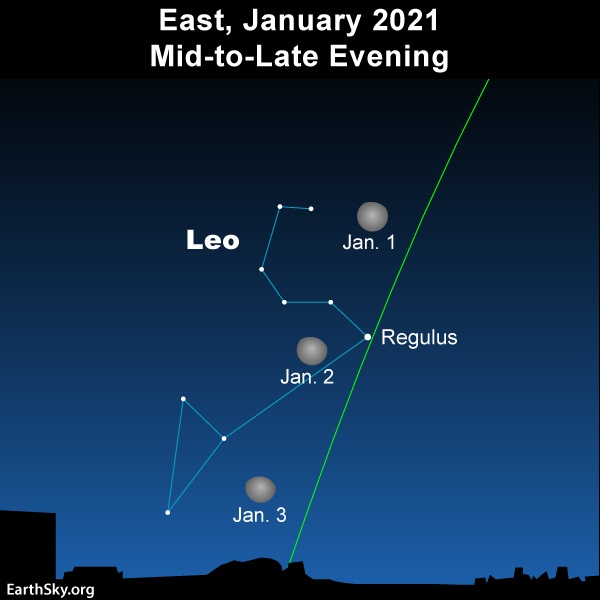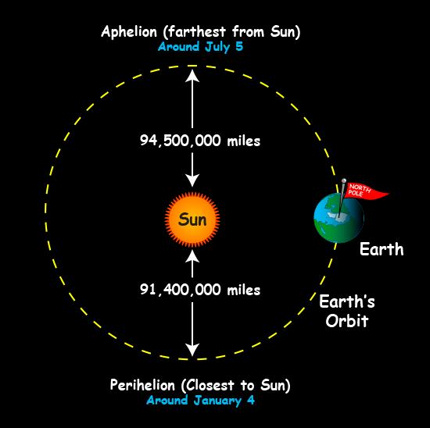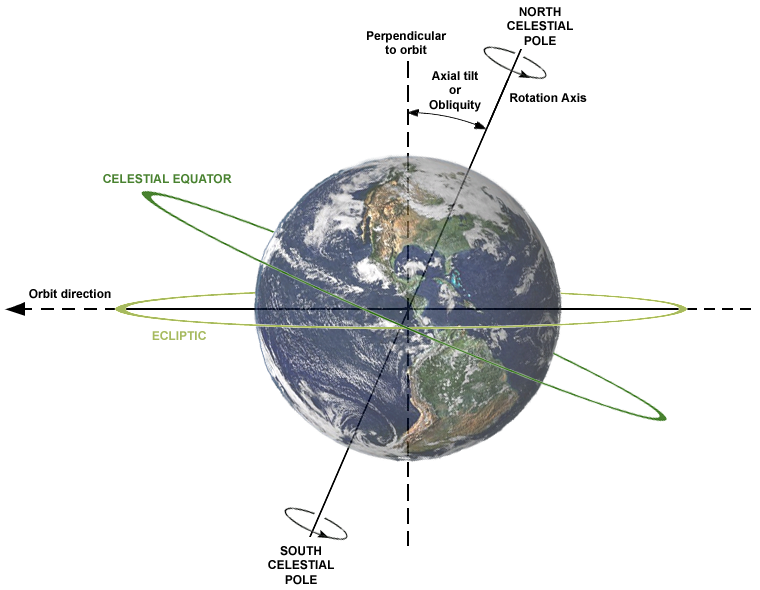
Cartoon above via Sara Zimmerman at Unearthed Comics.
Our planet Earth will reach its closest point to the sun for 2021 on January 2, at 13:51 UTC. In United States time zones, that’s January 2 at 8:51 a.m. Eastern Time, 7:51 a.m. Central Time, 6:51 a.m. Mountain Time, 5:51 a.m. Pacific Time, 4:51 a.m. Alaskan Time and 3:51 a.m. Hawaiian Time. Translate UTC to your time.
Astronomers call this celebrated point in Earth’s elliptical orbit around the sun perihelion, from the Greek roots peri meaning near and helios meaning sun.
Best New Year’s gift ever! EarthSky moon calendar for 2021
At its closest point, Earth swings to within 91,399,453 miles (147,093,162 km) of the sun. That’s in contrast to six months from now, when the Earth reaches aphelion – its most distant point – on July 5, 2021. Then we’ll be 94,510,889 miles (152,100,533 km) from the sun.

Our planet Earth swings closest to the sun every year in early January. But this year, in 2021, the moon sweeps in front of the constellation Leo the Lion is early January 2021.
In other words, Earth is roughly 3 million miles (5 million km) closer to the sun in early January than it is in early July. That’s always the case. Earth is closest to the sun every year in early January, when it’s winter for the Northern Hemisphere.
We’re farthest away from the sun in early July, during our Northern Hemisphere summer.
Source: Fred Espenak’s Earth at perihelion and aphelion, 2001 to 2100

Image via NASA.
So you see there’s not a huge distance difference between perihelion and aphelion. Earth’s orbit is very nearly circular. Thus it’s not our distance from the sun – but instead the tilt of our world’s axis – that creates winter and summer on Earth.
In winter, your part of Earth is tilted away from the sun. In summer, your part of Earth is tilted toward the sun. The day of maximum tilt toward or away from the sun is the December or June solstice.
Though not responsible for the seasons, Earth’s closest and farthest points to the sun do affect seasonal lengths. When the Earth comes closest to the sun for the year, as around now, our world is moving fastest in orbit around the sun. Earth is rushing along now at almost 19 miles per second (30.3 km/sec) – moving about 0.6 miles per second (one kilometer per second) faster than when Earth is farthest from the sun in early July. Thus the Northern Hemisphere winter and – simultaneously – the Southern Hemisphere summer are the shortest seasons as Earth rushes from the solstice in December to the equinox in March.
In the Northern Hemisphere, the summer season (June solstice to September equinox) lasts nearly five days longer than our winter season. And, of course, the corresponding seasons in the Southern Hemisphere are opposite. Southern Hemisphere winter is nearly five days longer than Southern Hemisphere summer.
It’s all due to the shape of Earth’s orbit. The shape is an ellipse, like a circle someone sat down on and squashed. The elliptical shape of Earth’s orbit causes the variation in the length of the seasons – and brings us closest to the sun in January.
Bottom line: In 2021, Earth’s closest point to the sun – called its perihelion – comes on January 2 at 13:51 Universal Time (at 8:51 a.m. CST).
Are the December solstice and January perihelion related?
from EarthSky https://ift.tt/322mINa

Cartoon above via Sara Zimmerman at Unearthed Comics.
Our planet Earth will reach its closest point to the sun for 2021 on January 2, at 13:51 UTC. In United States time zones, that’s January 2 at 8:51 a.m. Eastern Time, 7:51 a.m. Central Time, 6:51 a.m. Mountain Time, 5:51 a.m. Pacific Time, 4:51 a.m. Alaskan Time and 3:51 a.m. Hawaiian Time. Translate UTC to your time.
Astronomers call this celebrated point in Earth’s elliptical orbit around the sun perihelion, from the Greek roots peri meaning near and helios meaning sun.
Best New Year’s gift ever! EarthSky moon calendar for 2021
At its closest point, Earth swings to within 91,399,453 miles (147,093,162 km) of the sun. That’s in contrast to six months from now, when the Earth reaches aphelion – its most distant point – on July 5, 2021. Then we’ll be 94,510,889 miles (152,100,533 km) from the sun.

Our planet Earth swings closest to the sun every year in early January. But this year, in 2021, the moon sweeps in front of the constellation Leo the Lion is early January 2021.
In other words, Earth is roughly 3 million miles (5 million km) closer to the sun in early January than it is in early July. That’s always the case. Earth is closest to the sun every year in early January, when it’s winter for the Northern Hemisphere.
We’re farthest away from the sun in early July, during our Northern Hemisphere summer.
Source: Fred Espenak’s Earth at perihelion and aphelion, 2001 to 2100

Image via NASA.
So you see there’s not a huge distance difference between perihelion and aphelion. Earth’s orbit is very nearly circular. Thus it’s not our distance from the sun – but instead the tilt of our world’s axis – that creates winter and summer on Earth.
In winter, your part of Earth is tilted away from the sun. In summer, your part of Earth is tilted toward the sun. The day of maximum tilt toward or away from the sun is the December or June solstice.
Though not responsible for the seasons, Earth’s closest and farthest points to the sun do affect seasonal lengths. When the Earth comes closest to the sun for the year, as around now, our world is moving fastest in orbit around the sun. Earth is rushing along now at almost 19 miles per second (30.3 km/sec) – moving about 0.6 miles per second (one kilometer per second) faster than when Earth is farthest from the sun in early July. Thus the Northern Hemisphere winter and – simultaneously – the Southern Hemisphere summer are the shortest seasons as Earth rushes from the solstice in December to the equinox in March.
In the Northern Hemisphere, the summer season (June solstice to September equinox) lasts nearly five days longer than our winter season. And, of course, the corresponding seasons in the Southern Hemisphere are opposite. Southern Hemisphere winter is nearly five days longer than Southern Hemisphere summer.
It’s all due to the shape of Earth’s orbit. The shape is an ellipse, like a circle someone sat down on and squashed. The elliptical shape of Earth’s orbit causes the variation in the length of the seasons – and brings us closest to the sun in January.
Bottom line: In 2021, Earth’s closest point to the sun – called its perihelion – comes on January 2 at 13:51 Universal Time (at 8:51 a.m. CST).
Are the December solstice and January perihelion related?
from EarthSky https://ift.tt/322mINa


Aucun commentaire:
Enregistrer un commentaire